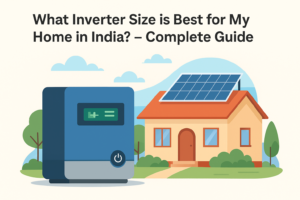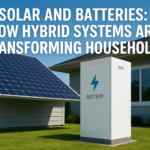Best Inverter Size for Home in India – Load Calculator & Buying Guide
Best inverter size for home in India is one of the most searched topics by homeowners looking for reliable power backup. Choosing the right inverter depends on your load calculation, battery capacity, and whether you want a normal or solar inverter setup.
In India, where frequent power cuts are still a reality in many cities and towns, an inverter has become more of a necessity than a luxury. Whether you live in a small apartment or a large independent house, having a reliable inverter ensures uninterrupted electricity for your essential appliances.
But the most common question people ask is – “What inverter size should I buy for my home?” Choosing the wrong size can lead to poor performance, shorter battery life, and even wasted money. This guide will help you understand how to calculate the right inverter capacity for your home in India, step by step.
1. Why Inverter Size Matters
The size (capacity) of your inverter determines how many electrical devices it can power during an outage and for how long. If you choose a smaller capacity than required, the inverter will get overloaded, leading to tripping and battery strain. On the other hand, if you choose an unnecessarily large capacity, you’ll end up spending more money without utilizing its full potential.
In simple terms:
– Under-sized inverter = frequent shutdowns during power cuts
– Over-sized inverter = higher cost, unnecessary power consumption

2. Understanding Inverter Capacity
In India, inverter capacity is measured in VA (Volt-Ampere), not Watts. The formula is:
Inverter Capacity (VA) = Total Power Requirement (Watts) ÷ Power Factor (usually 0.8)
The Power Factor accounts for energy losses in the conversion process. For home inverters, it’s generally taken as 0.8.
3. Step-by-Step Inverter Load Calculation for Your Home
Let’s break it down with an example.
Step 1: List all the devices you want to run during a power cut.
Example:
– 3 Ceiling Fans (70W each) → 210W
– 5 LED Bulbs (10W each) → 50W
– 1 LED TV (120W) → 120W
– 1 Wi-Fi Router (15W) → 15W
– 1 Laptop (50W) → 50W
Total Wattage = 210 + 50 + 120 + 15 + 50 = 445W
Step 2: Apply the Power Factor.
Inverter capacity (VA) = 445 ÷ 0.8 = 556 VA.
Step 3: Choose the nearest higher standard size.
In India, inverters usually come in sizes like 600 VA, 800 VA, 1050 VA, 1500 VA, etc.
For the above example, a 600–800 VA inverter would be suitable.
4. Popular Inverter Sizes in India and Their Uses
Here’s a quick guide to common inverter capacities and the type of households they suit:
| Inverter Size (VA) | Ideal For | Example Usage |
|---|---|---|
| 600–800 VA | Small apartments | 2–3 fans, 4–5 lights, 1 TV |
| 1050–1500 VA | Medium homes | 4–5 fans, 6–8 lights, TV, Wi-Fi, laptop |
| 2kVA–3kVA | Large homes | Fans, lights, TV, fridge, computer |
| 5kVA+ | Villas, offices | Multiple appliances, air conditioners |
5. Considering Battery Size Along with Inverter
The inverter is only half the equation – the battery stores the energy. A larger battery gives longer backup.
Battery capacity is measured in Ah (Ampere-hour). For most homes:
– 100–150 Ah → 3–5 hours backup
– 150–200 Ah → 6–8 hours backup
– Tubular batteries last longer and are better for Indian conditions.
6. Solar vs Normal Inverters
With electricity bills rising and solar adoption increasing in India, many people are choosing solar hybrid inverters.
– Normal Inverter: Works only on grid power + battery
– Solar Inverter: Uses solar panels + battery + grid power
– Hybrid Inverter: Can switch between solar and grid automatically
If you live in sunny regions like Rajasthan, Gujarat, Maharashtra, or Tamil Nadu, a solar inverter can reduce your electricity bill significantly.
7. Factors to Consider Before Buying
Here are some key things to keep in mind before finalizing your inverter size:
1. Load Requirement – Decide what devices you really need during a power cut.
2. Backup Time – If you face long outages, go for a bigger battery.
3. Appliance Type – Motors (like fridge, mixer) need more starting power.
4. Future Needs – If you plan to add more devices later, choose a slightly bigger capacity now.
5. Brand & Warranty – Trusted brands like Luminous, Microtek, V-Guard, Exide, Sukam offer better after-sales support.
6. Energy Efficiency – Always choose inverters that meet Bureau of Energy Efficiency (BEE) guidelines. Higher energy efficiency means lower electricity consumption and reduced long-term costs.
8. Mistakes to Avoid While Choosing Inverter Size
– Buying based only on price, not actual load needs.
– Ignoring battery capacity – big inverter + small battery = poor performance.
– Overloading the inverter regularly – reduces lifespan.
– Not considering solar option for long-term savings.
Final Recommendation
For a typical 2BHK home in India, a 1050–1500 VA inverter with a 150–200 Ah tubular battery is the most balanced choice. It can easily run essential lights, fans, TV, Wi-Fi, and a laptop for 4–6 hours.
If you live in an area with frequent and long power cuts, consider a solar hybrid inverter with adequate battery backup. It may cost more initially but will save money in the long run.
Choosing the right inverter size for your Indian home is not guesswork – it’s a simple calculation based on your load requirements and backup needs. By understanding how inverters work, calculating your power needs, and considering factors like battery size and future expansion, you can invest in a system that provides reliable, efficient, and long-lasting power backup.
Always buy from a trusted dealer and get proper installation. A good inverter setup can last 5–7 years with proper maintenance, keeping your home powered and your family comfortable during outages.


 Previous Post
Previous Post Next Post
Next Post